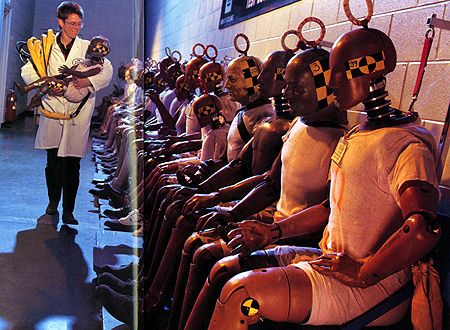| SEATBELT.COM |
[an error occurred while processing this directive]
|
|
EVERYONE
DESERVES TO BE SAFE ON THE ROAD
|
|
|
Search |
 As day ends at GM safety test lab, engineer Kadie Davis surveys repaired dummies, ready for the next crash. force of the impact can cause the placenta to separate from the uterus, killing the fetus and possibly the mother as well. While Viano and Pearlman perfect their dummy, they advise pregnant women to wear seat belts with the shoulder harness passing between the breasts and with the lap belt low, under the protruding abdomen. "Our long-term goal is to redesign cars," says Viano. "Our short-term goal is better behavior." Eventually, the expectant dummy will join the rest of the Hybrid III family in smashups at the Milford Proving Grounds. Anita Hess, who manages Milford's Safety Test Laboratory, checks preparations for such a test one afternoon in a cavernous room that could be a space shuttle hangar. To one side sit dummy retirees, including the 1946 Parachute Man, as if contemplating their grandchildren's travails. Technicians work on a metallic blue Chevrolet Silverado pickup truck, not due in showrooms for a couple of years. A 50th Percentile Male Hybrid III sits at the wheel, wearing his seat belt. The truck will hit a steel-and-plywood barrier at 30 mph. The aim is to make sure the truck's air bag and windshield match federal safety regulations. Anita Hess watches from a control room, where buttons are flashing red, green and amber, and switches fill the surface of an intimidating console bearing labels like "Tension System Ready" and "System Armed." It ends as it always does, in a split second, with a bang. The truck crumples. The dummy bounces alarmingly, face into the air bag. It has already sent its data to the computers. Now it will go to the hospital, removed by a crane and carted away in a wooden wheelchair. After recalibration, it will be ready for another smashup. Eventually, these dummies may lose their jobs. Engineers are now testing on-screen computer dummies that crash virtual cars in the cyberworld. "Someday," says GM engineer Annette Irwin, "we may have a model human on the computer instead of a crash dummy, with a heart and lungs and all the other vital organs." Far off, the goal is cars that sense who is sitting in them and adjust their safety features accordingly. Meanwhile, crash testing is still a job for a dummy. David Viano once saw an Italian translation: "Hybrid III Stupido." Stupid they may be. But they also are our loyal simulacra, taking our hits. And at the Milford Proving Grounds, after work in the evening, they sit in a long row as if communally nursing their aches. "On Friday nights I'm often the last one out of here," says Anita Hess, eyeing the line of dummies sitting in the dark. "I still have trouble walking down that row they're kind of eerie." |